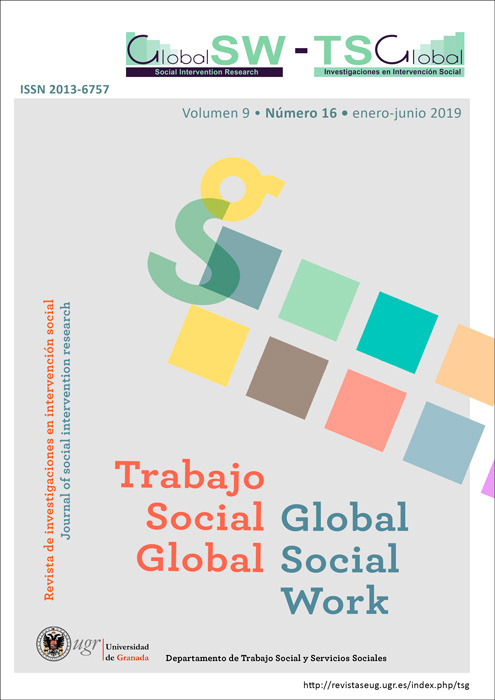Jóvenes que ni estudian ni trabajan (‘NINIS’): una aproximación a sus características en el marco socioeconómico y político actual en la provincia de Sevilla (España)
DOI:
https://doi.org/10.30827/tsg-gsw.v9i16.8239Palavras-chave:
Desempleo juvenil, ‘nini’, mercado laboral, formación permanente, exclusión socialResumo
En este artículo se analiza la formación y actitudes hacia el empleo del colectivo social denominado NINI –jóvenes que ni estudian ni trabajan– en el marco sociopolítico actual, marcado por una alta tasa de desempleo juvenil que se mantiene a pesar de la recuperación económica pregonada en los últimos meses. Su finalidad es conocer las características socioculturales en las que han crecido y su valoración acerca de la formación académica recibida para su desarrollo personal, social y laboral. Para alcanzar este objetivo se ha recurrido a una metodología mixta fundamentada en un enfoque cuantitativo y cualitativo. Los instrumentos utilizados para la recogida de los datos han sido la entrevista y el cuestionario. Los resultados obtenidos muestran la heterogeneidad de este colectivo, en el que existe una mayor presencia de jóvenes que buscan empleo activamente, con estudios postobligatorios y superiores, frente a la imagen tradicional que los identifica como jóvenes ociosos, desinteresados y sin formación ni cualificación profesional.
Downloads
Referências
Aguilera, R.M., Durand-Smith, A., Rodríguez, E.M. y Romero, M. (2004). Veinticinco años de investigación cualitativa en salud mental y adicciones con poblaciones ocultas. Salud Mental, 26(6), 76-83.
Arnold, C., & Baker, T. (2012). Transitions from school to work: Applying psychology to NEET. Educational and Child Psychology, 29(3), 67-80. doi: http://doi.org/10.1016/j.ecresq.2011.12.009
Balan, M. (2014). Youth labor market vulnerabilities: characteristics, dimensions and costs. Procedia Econocmics and Finances, 8, 66-72.
Batini, F., Corallino, V., & Toti, G. (2017) NEET: A phenomenon yet to be explored. Interchange, 48(1), 19-37. doi:10.1007/s10780-016-9290-x
Bruno, G., Marelli, E. & Signorelli, M. (2014). The rise of NEET and youth unemployment in EU regions after the crisis. Comparative Economic Studies, 56(4), 592-615, doi:10.1057/ces.2014.27
Carcillo, S., Fernández, R., Köning, S. & Minea, A. (2015). NEET Youth in the Aftermath of the Crisis: Challenges and Policies. OECD Social, Employment and Migration Working Papers, 164. París: OECD Publishing. doi: https://doi.org/10.1787/5js6363503f6-en
Comisión Europea (2010). Europa 2020: Una estrategia para un crecimiento inteligente, sostenible e integrador. Comunicación de la Comisión al Parlamento Europeo, al Consejo, al Comité Económico y Social Europeo y al Comité de las Regiones. COM (2010) 553 final. Bruselas, 6.10.2010. Recuperado de:
http://eur-lex.europa.eu/LexUriServ/LexUriServ.do?uri=COM:2010:2020:FIN:ES:PDF.
______________ (2013). Recomendación del Consejo, de 22 de abril de 2013, sobre el establecimiento de la Garantía Juvenil (2013/C 120/01). Diario Oficial de la Unión Europea, C120, 26 de abril de 2013. Recuperado de https://eur-lex.europa.eu/legal-content/ES/TXT/?uri=OJ:C:2013:120:TOC
Fernández-Sierra, F. y Santos-Bocero, L (2014). Orientar las transiciones del alumnado inmigrante: más que un reto multiprofesional. Revista Española de Orientación y Psicopedagogía, 25(2), 8-23. doi:10.5944/reop.vol25.num.2.2014
Furlong, A. (2006). Not a very NEET solution: Representing problematic labour market transitions among early school-leavers. Work, Employment and Society, 20(3), 553-569.
Gómez-Torres, M.J. (2017). Aprendizaje permanente y competencias emocionales frente a la precariedad laboral: los trabajadores pobres. En F.J. Calvo y M.R. Gómez-Álvarez (Dir). Trabajadores pobres y pobreza en el trabajo (pp. 409-446). Murcia: Ed. Laborum.
Gómez-Torres, M.J. y Ordóñez-Sierra, R. (2014). Las transiciones de la formación al trabajo de los jóvenes españoles en el marco de las medidas educativas contempladas en la Estrategia de Emprendimiento y Empleo Joven 2013/2016. Temas Laborales: Revista andaluza de trabajo y bienestar social, 127, 179-220.
Holt, B.H. (2017). Counying and meeting neet young people: methodology, perspective and meaning in research on marginalized youth. Young, 26(1), 1-16.
doi: 10.1177/1103308816677618
INE (2017). Encuesta de Población Activa. Tercer Trimestre del año 2017. Recuperado de: http://www.ine.es/jaxiT3/Datos.htm?t=4086.
INJUVE (2011). Desmontando a ‘nini’. Un estereotipo juvenil en tiempos de crisis. Madrid: Instituto de la Juventud. Recuperado de: http://www.injuve.es/sites/default/files/9206-01.pdf
Jones, O. (2012). CHAVS. La demonización de la clase obrera. Madrid: Capitan Swing.
Kelly, E. & McGuinness, S. (2015). Impact of the Great Recession in unemployed and NEET individual´s labour market transition in Ireland. Economomic System, 39(1), 59-71, doi:10.1016/j.ecosys.2014.06.004.
Kraak, A. (2013). State failure in dealing with the NEET problem in South Africa: Which way forward? Research in Post-Compulsory Education, 18(1-2), 77-97.
doi:10.1080/13598748.2013.755819
Lawy, R., Quinn, J. & Diment, K. (2010). Responding to the 'needs' of young people in jobs without training (JWT): Some policy suggestions and recommendations. Journal of Youth Studies, 13(3), 335-352. doi:10.1080/13676260903447544
Maguire, S. (2013). Will raising the participation age in England solve the NEET problem?. Research in Post-Compulsory Education, 18(1-2), 61-76.
doi:10.1080/13596748.2013.755816
_________ (2015). NEET, Unemployment, Inactive or Unkown- Why does it matter?. Educational Research, 57(2), 121-132. doi:10.1080/00131881.2015.1030850
Mantecón, A., Juan, M., Calaft, A., Becoña, E. y Román, E. (2008). ‘Respondent-Driven Sampling’: un nuevo método de muestreo de poblaciones visibles y ocultas. Adicciones, 20(2), 161-169.
Müler, W. & Gangl, M. (2006). The transition from school to work: a European perspective. En W. Müller & M. Gangl (Coord). Transition from Education to Work in Europe. The Integration of Youth into EU Labour Markets (1-19). New York: Oxford University Press.
Nardi, B., Licarelli, C., Talamonti, M., Arimatea, E., Fiori, V. & Moteldo-Perfetti, A. (2015). NEET versus EET´s: and observacional study in Italy. Research in Post-Compulsory Education, 20(4), 377-399. doi:10.1080/13596748.2015.1081749
OCDE (2015). Education at a Glance 2015: OCDE Indicators. París: OCDE Publishing. doi: https://doi.org/10.1787/eag-2015-en
Olmos Rueda, P. y Más Torelló, O. (2013). Jóvenes, fracaso escolar y programas de segunda oportunidad. Revista Española de Orientación y Psicopedagogía, 24(1), 78-93. doi:10.5944/reop.vol24.num.1.2013
Outón, P. y Suárez, A. (2010). Adaptación y validación del test de dislexia Bangor. Revista de Investigación Educativa, 28(2), 445-457.
Pemberton, S. (2008). Tackling the NEET generation and the ability of policy to generate a 'NEET' solution - Evidence from the UK. Environment and Planning C: Government and Policy, 26(1), 243-259. doi:10.1068/c0654
Reiter, H. & Schimbach, T. (2015). NEET in disguise? Rival narrative in troubled youth transition. Educational Reseach, 57(2), 133-150. doi:10.1080/00131881.2015.1030848
Rodríguez-Gallego, M., López-Martínez, A. y Ordoñez-Sierra, R. (2011). Validación del inventario sobre necesidades formativas del alumnado (INFA) en el “prácticum” de Pedagogía. Revista de Docencia Universitaria, 9(2), 163-181.
Simmons, R., Russell, L. & Thompson, R. (2014). Young people and labour market marginality: Findings from a longitudinal ethnographic study. Journal of Youth Studies, 17(5), 577-591. doi:10.1080/13676261.2013.830706
Smith, R. & Writh, V. (2015). The posibilities of re-engangement: cultures of literacy education and so-called NEETs. Research in Post-Compulsory Education, 20(4), 400-418. doi:10.1080/13596748.2015.1081751
Smyth, J., Robinson, J. & McInerney, P. (2014). It's our turn - young people 'tilting' the neoliberal turn. Journal of Youth Studies, 17(4), 492-509. doi:10.1080/13676261.2013.830705
Stainback, W. & Stainback, S. (1984). A Rationale for the merger of regular and special education. Exceptional Children, 51, 102-111. doi:10.1177/00144029805100122
Thompson, R. (2011). Individualisation and social exclusion: The case of young people not in education, employment or training. Oxford Review of Education, 37 (6), 785-802. doi:10.1080/03054985.2011.636507
Yates, S. & Payne, M. (2006). Not so NEET? A critique of the use of 'NEET' in setting targets for interventions with young people. Journal of Youth Studies, 9(3), 329-344, doi:10.1080/13676260600805671
Downloads
Publicado
Como Citar
Edição
Secção
Licença
Os autores que publiquem nesta revista estão de acordo com os seguintes termos:
- Os autores conservam os direitos de autor e garantem à Trabalho Social Global o direito à primeira publicação do trabalho.
- Os autores estão cientes de que a sua obra é publicada de acordo com uma Licença Creative Commons, que permite a terceiros compartilhá-la com reconhecimento da autoria do trabalho e da sua publicação inicial nesta revista.
- Os autores podem distribuir a versão da obra publicada na Trabalho Social Global (por exemplo, disponibilizá-la num repositório institucional ou publicá-la num livro), com um reconhecimento expresso da sua publicação inicial nesta revista.




















